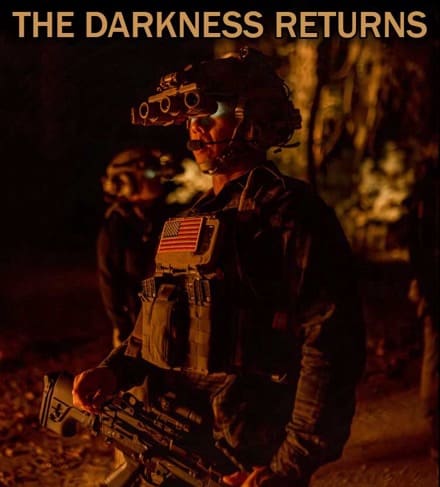
Look for the new DarkVault next week in both Comms and Signal Blocking versions.
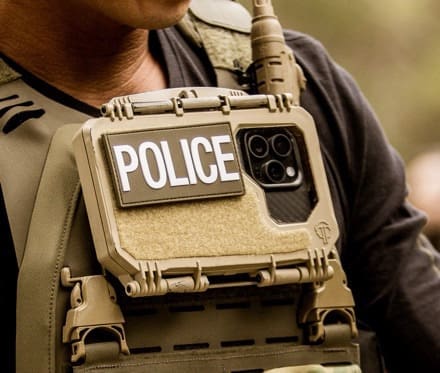
Following the initial announcement in January 2024, Spectra Group are springboarding the GENSS system into the US market at SOF 24. Spectra Group, a specialist provider of secure voice, data and satellite communications systems, is showcasing its next generation of tactical radio communications GENSS (pronounced genesis /j?n??-s?s) at SOF Week 2024 and will be displayingGENSS and the highly popular SlingShot from 6-10 May 2024 in booth #1805 at the Tampa Convention Centre.
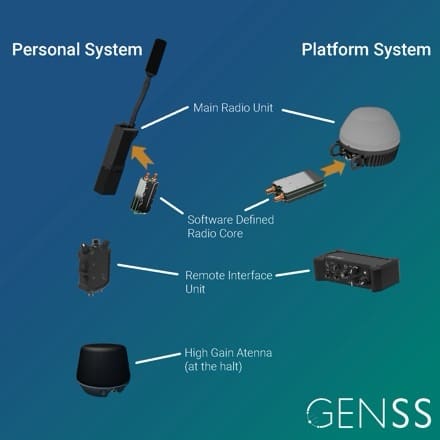
GENSS builds on the foundations created by their award-winning SlingShot system, embodying Spectra Group’s vision of producing the ultimate radio systems that capitalize on technological advances, adapt to the evolving demands of military operations and simplify the user experience. It has been designed and developed through a collaborative effort of tactical communication experts, seasoned military specialists and top-tier U.K. scientists and engineers. GENSS is a significant advancement in the field of tactical radio communications, due to its modular core framework and software-defined flexibility, heralding a new era in communication technology.
This modular, agnostic hardware radio system is designed to be agile and provide the ultimate interoperability through straightforward software reprogramming to adapt quickly and easily to meet the diverse needs of its users. Capable of operating across HF, VHF, UHF, and satellite bands, GENSS is engineered to conquer Beyond Line-of-Sight (BLOS) barriers and support Communications on the Move (COTM), delivering a robust and agile solution for voice and high-bandwidth data transmission across all domains — land, sea, and air. GENSS boasts high-capacity, network sensing capabilities and has increased data rates over 25kHz LTAC channels, scaling up to 90kBps. It has adaptive modulation waveforms, which automatically adjust through network sensing techniques, to meet the tactical situation (on the move and in combat vs at the halt scenarios). Also, through novel engineering techniques, voice and low data rate solutions can be applied in the contested communications space to minimise detection.
This revolutionary radio solution can stand alone or be integrated into any existing radio infrastructure and works seamlessly with SlingShot; unleashing superior interoperability and flexibility to meet the demands of today and the future. By integrating multi-mission and multi-mode functionalities, combined with its modular design and open architecture, it delivers unparalleled adaptability for robust battlefield connectivity. Secure by design and integrating the latest most advanced technological hardware means GENSS not only delivers maximum performance while minimizing its size, weight and power, but also delivers a future-proofed capability. In addition, it is simple to operate and configure, with an easy-to-programme user interface, resulting in an overall reduced training burden.
Simon Davies, Chief Executive at Spectra Group, said: “For years, my vision has been to craft the ultimate radio system — user-friendly, light, modular and supremely flexible to adapt to the evolving demands of military operations and technological advances. After years of dedicated development, GENSS is the fruition of that vision and builds on the foundations set by our award-winning SlingShot system. Designed by soldiers, for soldiers, GENSS is not just a game-changer for military applications but possesses vast potential for integration into broader communication networks, unlocking endless possibilities.”
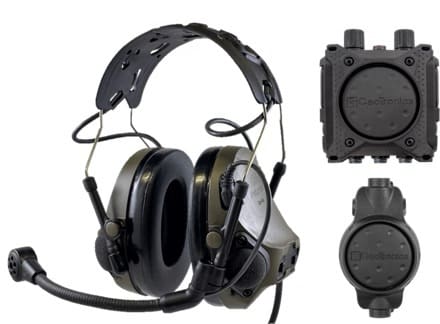
Rheinmetall has been commissioned by the Bundeswehr in a key project for tactical communications which is of cross-sectional importance for the entire force. The technology company has been contracted to supply up to 191,000 sets of the “intercom with hearing protection function”. The framework contract has a seven-year term and a potential order volume of up to €400 million net.
The Budget Committee of the German Bundestag had imposed conditions on the project. 30,000 sets including connection cables with delivery in 2024 have been firmly ordered. A call-off for the delivery of a further 30,000 sets for 2025 is expected. These two delivery batches financed from the special fund will have a net value of up to around €140 million.
The intercom with hearing protection function (abbr. SmG in German, for “Sprechsatz mit Gehörschutz¬function”) includes modern active capsule ear protection that attenuates harmful impulse noise and amplifies quiet sounds. It also has a microphone and can be connected to various radio devices so that radio communication is possible. In addition to the combined headset, the scope of supply includes various push-to-talk (PTT) buttons and different cable sets for connecting to a range of radios and on-board communication systems. Rheinmetall has involved two leading manufacturers as subcontractors for the project: 3M Peltor with the ComTac VIII headset and CeoTronics AG with CT-Multi PTT 1C and 3C. The SmG is compatible with the Rheinmetall-supplied new combat helmet as well as with other Bundeswehr helmet types.
This order underlines Rheinmetall’s leading role in the field of military equipment. The technology company is the prime contractor for the System Infantry Soldier of the Future – Expanded System to the Bundeswehr. Rheinmetall markets various configurations of its Gladius soldier system internationally.
Melbourne, Florida/ 15 April 2024 – SD GovernmentSDG, the satellite communications provider for global governments and the US Air Force, has successfully tested the Roll-on/Roll-off (RO/RO) Beyond Line of Sight (BLOS) satellite communications (SATCOM) capability SDG developed with Florida-based R4 Integration, Inc. (R4i) in a 26-hour 20-minute mission aboard a Lockheed Martin C-130J-30 Hercules. Following the intense validation flight, the SD/R4i Tactical Removeable Airborne Satellite Communications (TRASC) BLOS solution is now fully available for US Air Force use.
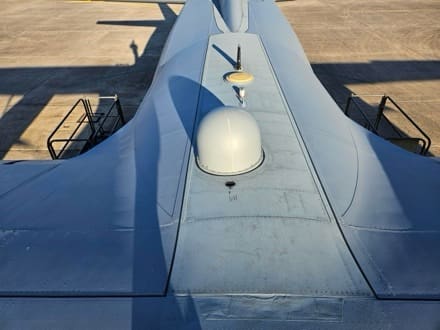
Performed as part of Exercise Gnarly Explodeo, the maximum endurance mission recorded 100% reliability and availability from the TRASC system as it facilitated secure command and control data communications, defense applications, intelligence updates, electronic flight bags, video conferencing, voice over internet and WiFi calls. The equipment connects with the Intelsat FlexAir service, which employs an optimized high-throughput global satellite network to deliver dedicated airtime to government users. The SD/R4i TRASC system supports the commander of Air Mobility Command (AMC), General Mike Minihan, in achieving his intention to have 25% of the AMC fleet connected by 2025.
The SD/R4i TRASC BLOS solution integrates the SD Plane Simple® Ku-band terminal within a Multi-Purpose Hatch System (MPHS) designed to replace the existing C-130 standard upper forward or center fuselage hatches.The SDG team assisted US Air Force maintainers as they installed the system on a 41st Airlift Squadron, 19th Airlift Wing C-130J, at Little Rock Air Force Base, Arkansas.
“This platform enables global command and control, providing our crew with unparalleled situational awareness,” remarked Colonel Denny Davies, 19th Airlift Wing and Little Rock commander, after the mission. “It makes the C-130 much more resilient and capable in the vastness of the Pacific, reinforcing the Air Force’s core tenant of distributed control.”
The turnkey solution mounts the SD Plane Simple® antenna in the MPHS. It includes a compact RO/RO BaseBand kit that integrates a secure enclave, modem, Link-16, airborne router, and power supply. The stand-alone system only requires AC or DC power from the aircraft to operate and distribute real-time BLOS connectivity.
“SD prides itself on rigorously testing all our equipment before we put it into service. The success of this endurance flight exemplifies the power of our advanced technology and its versatility in delivering new capabilities to our forces. We are proud to add this connectivity solution to our growing military portfolio and look forward to supporting the system as it enters into service,” says Hayden Olson, Head of SD Government. “We are already receiving requests for demonstrations of the capabilities of the equipment to USAF representatives, such is the interest in the system.”
www.satcomdirect.com/government

· Operator Centric Design – Low SWaP profile, streamlined cabling and unified power reduces operator load-out
· Powerfully Advanced Networking Performance– Seamlessly scale from tactical Personal Area Network to wide-area mesh networks connecting hundreds of nodes
· Designed for the Universally Connected Warfighter – Integrated Samsung S23TE provides mission-ready mobility and powerful on-board processing with advanced security features
· Soldier Worn AI – Select models feature powerful on-board NVIDIA Jetson Nano AI CPU providing flexible edge computing in any environment
· Achieve Spectrum Dominance – Access an expansive suite of LPI/LPD and Anti-Jamming resiliency capabilities for secure and protected communications in contested environments
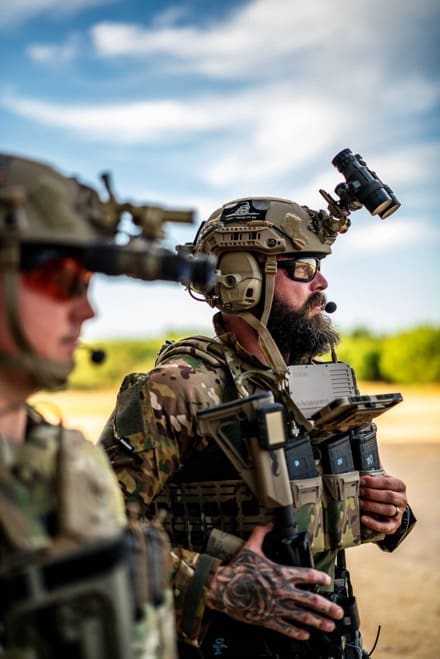
Los Angeles, California (April 16, 2024) – Silvus Technologies, Inc. (“Silvus”), a global leader in advanced wireless networking communication systems, and Kägwerks, a global leader in solutions for tactical operator-worn networking have joined forces to introduce DOCK (Dismounted Operator’s Combat Kit) StreamCaster, the next generation of Tactical Networking Systems.
Designed for the Universally Connected Warfighter, DOCK StreamCaster combines advanced StreamCaster MANET (Mobile Ad-hoc Network) radios with Samsung’s S23TE EUDs (End User Device) in one fully integrated chest-mountable DOCK system. Compact and lightweight, each DOCK StreamCaster features a rugged, low SWaP profile and modular design, with streamlined cabling and unified power that reduces operator load-out while increasing mobility and mission effectiveness.
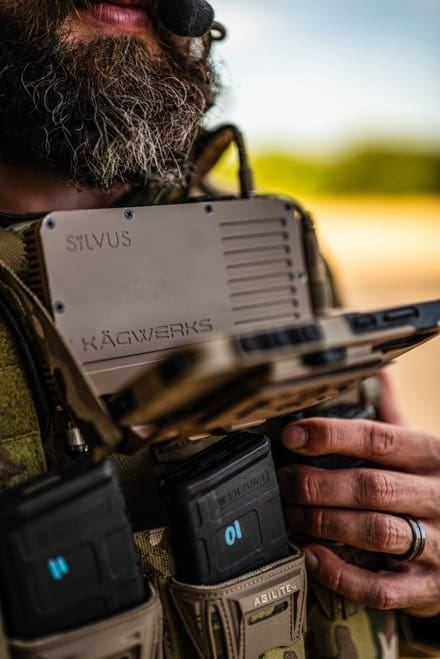
Integrated StreamCaster MANET radio delivers up to 4W native output power (8W effective power thanks to TX Eigen Beamforming) and up to 100 Mbps data rate, optimizing network efficiency for video, voice, and IP data communications. At the heart of every DOCK StreamCaster is Silvus’ proprietary MN-MIMO waveform technology that creates a self-forming and adaptive mesh network – capable of linking hundreds of nodes with unmatched range, throughput, EW resiliency and scalability. With available access to Silvus’ Spectrum Dominance expansive suite of Low Probability of Intercept/Low Probability of Detection (LPI/LPD) and Anti-Jamming resiliency capabilities – DOCK StreamCaster provides operators with secure and protected communications in congested and contested environments.
Direct connection to Samsung’s S23TE (sold separately) provides mission-ready mobility with powerful on-board processing, advanced security, and exclusive MilSpec features. Built-in ATAK, Intra-Soldier Wireless and Nett Warrior connectivity empower operators with increased situational awareness and mission planning, with instant access to networked devices and soldier-worn peripherals. On select models, powerful on-board NVIDIA Jetson Nano AI module enables DOCK StreamCaster to create a common operational picture, delivering decision superiority at the tactical edge.
“The DOCK StreamCaster represents a strategic fusion of Silvus’ advanced StreamCaster radios with Kägwerks’ expertise in developing top-tier dismount solutions for the elite operator,” said Jimi Henderson, Vice President of Sales for Silvus Technologies. “This collaboration elevates tactical communications, delivering unparalleled connectivity and situational awareness to empower our forces in the most demanding environments.”
“We’ve partnered with Silvus Technologies and its industry-leading MANET radio technology to provide today’s universally connected warfighter with a powerfully advanced networking solution that will increase their lethality and survivability in today’s dynamically changing battlespace,” said Niko Hughes, President of Kägwerks. “As the latest addition to the Kägwerks DOCK ecosystem, we’ve designed DOCK StreamCaster to be as modular and future forward as possible – to give operators the power and versatility they need to stay connected for mission success, no matter where it takes them.”
One tactical networking solution – multi-mission capabilities. The DOCK StreamCaster family of modular and scalable solutions include:
· DOCK SC4240P – The most powerful DOCK Tactical Networking System available, with up to 4 Watts output power (8 Watts effective, thanks to TX Eigen Beamforming), and up to 100 Mbps of data throughput to support high bandwidth video, voice, and data communications.
· DOCK ULTRA SL4210P – Designed for the Team Leader and individual warfighter with advanced MANET mesh networking capabilities, powerful on-board AI computing and edge processing capabilities.
· DOCK SL4210P – Compact, lightweight, and powerfully connected with built-in Intra-Soldier Wireless network, it seamlessly scales from a tactical Personal Area Network to wide-area mesh networks connecting hundreds of nodes.
Lear more about the family of DOCK StreamCaster Tactical Networking Systems at www.silvustechnologies.com and kagwerks.com, and follow us on LinkedIn to get the latest news.
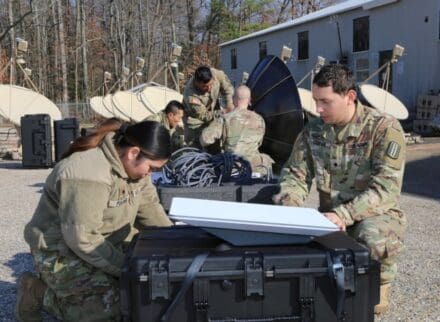
ABERDEEN PROVING GROUND, Md. — A new pilot will inform Army decisions on a lease-versus-buy business model for acquiring and delivering scalable commercial satellite communications to support unit readiness and unique missions in future large-scale combat operations.
To kick off the pilot — known as Satellite Communications (SATCOM) as a Managed Service, or SaaMS — the Army is fielding different bundled commercial equipment, bandwidth and service packages to units in several regional coverage areas around the globe.
Instead of the Army having to procure, field, sustain and modernize equipment on its own for every unit and every mission, SaaMS could enable the Army to lease these capabilities at the point of need. This business model would be scalable to expand or contract as missions change, helping to reduce on-hand inventory, satellite airtime and cost. SaaMS would ensure bandwidth is allocated at the right place and time to support data exchange in a wide variety of mission sets.
“In today’s dynamic [operational] environment, a SaaMS model could allow us to scale and adapt network connectivity seamlessly,” said Col. James Sullivan, commander, 11th Corps Signal Brigade, one of several units supporting the pilot. “We could easily increase or decrease bandwidth and services based on mission requirements, unlike fixed capacity with owned equipment. This flexibility is crucial for diverse missions across Europe, the Pacific or the Arctic.”
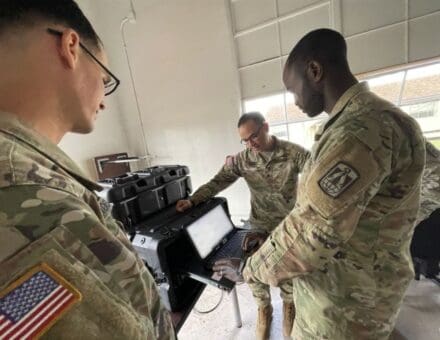
The Army will leverage the data and Soldier feedback from the pilot and other DOD efforts to make informed decisions on the implementation of SaaMS to meet the increasing demand for secure reliable satellite communications.
In line with the Army’s Unified Network Plan, a SaaMS model could help the service to more affordably keep up with the accelerating speed of technology advancement, while reducing, equipment obsolescence and other sustainment challenges. Solutions will be flexible and tailorable to meet the needs of specific mission sets and enable SATCOM connectivity and hardware to be surged for deployments or humanitarian assistance and disaster relief missions.
Sullivan added that instead of having fixed assets tied to specific locations, SaaMS could allow units to more freely allocate resources globally as needed.
“Imagine seamlessly shifting resources from a quiet Pacific base to a suddenly active European theater,” Sullivan said.
The SaaMS Pilot encompasses commercial capability in both low Earth orbit and the traditional geosynchronous Earth orbit constellations. Leveraging SaaMS’ multi-vendor, multi-orbit SATCOM capability could fuel the Army’s efforts to enhance network resiliency through transport diversity, especially in denied, degraded, intermittent and limited bandwidth environments.
The pilot also includes network connectivity to commercial teleports and internet services, and the Army is integrating the commercial capability into Global Agile Integrated Trasport network design, enabling units to tie into the unified network from anywhere in the world.
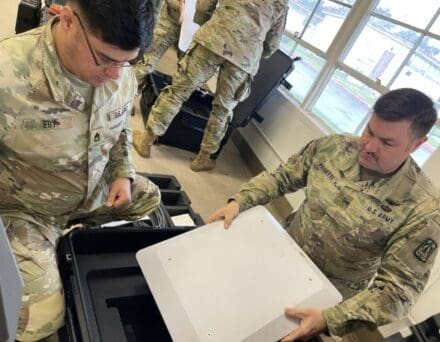
“SaaMS strengthens our primary, alternate, contingency, emergency (PACE) communications plan and network resiliency through redundancy,” said Lt Col. John “Chris” Acosta, deputy commander for the 11th CSB. “We can access diverse, geographically dispersed network providers. This could ensure communication even if specific regions face disruption.”
Further enhancing resiliency and ease of use, SaaMS allows for quicker signal rerouting and failover to alternate providers through the use of commercial auto-PACE software technology, minimizing downtime and mission impact, Acosta said.
Project Manager Tactical Network, assigned to the Program Executive Office Command, Control, Communications-Tactical, manages the SaaMS Pilot for the Army and expects to complete training and fielding the regional pilot units this spring. The intent of the pilot is not to create a separate SaaMS evaluation event, but to enable operational units to use the different service and equipment sets to best suit their individual needs and roll it into their existing training events through fiscal year 2024.
During the pilot, the Army will assess varying degrees of leased end-to-end service models, with tailorable features that include satellite terminals, bandwidth capacity, security compliance, logistics and repair, said Lt. Col. Mark Scott, product manager for Unified Network Capabilities and Integration — or PdM UNCI — assigned to Project Manager Tactical Network.
“As our adversaries strive to enhance their own network capabilities, agile procurement methods will be critical to U.S. forces in retaining technological overmatch on the battlefield, and it will enable us to more rapidly refresh units with dated equipment,” Scott said. “By leveraging commercial research and development, SaaMS could enable the Army to securely integrate emerging commercial capabilities into its SATCOM fleet at a much quicker pace and at less cost, compared to procuring capability through traditional methods with lengthy acquisition cycles.”

During the pilot, the Army will assess different scenarios, such as using SaaMS to provide a stop gap for maintenance issues due to obsolescence, or to rapidly deliver the “latest and greatest” in commercial technology to an Army National Guard unit prior to a deployment, said Seth Chouinard, PdM UNCI SaaMS project lead.
“If a unit that hasn’t deployed in several years and is then called up to support a mission, SaaMS becomes the solution for rapid equipment refresh,” Chouinard said. “When their deployment mission concludes, the unit can simply return the equipment back to the industry partner.”
If fielded to a National Guard joint force headquarters, SaaMS could also allow for quicker deployment for domestic response operations, said Cpt. Sam Stout, signal officer for the Virginia Army National Guard 29th Infantry Division, another of the pilot units.
“You can pack it into the back of a truck and roll it out with pretty much any of the communications packages we have now, versus our current large trailer-mounted satellite terminal,” Stout said. “With this [more expeditionary] satellite terminal, we could set up a response cell pretty much anywhere.”
Stout also noted that the commercial equipment is also easy to use and train, aiding in the Army’s network design goal to enhance simplicity at edge so Soldiers can focus on the fight.
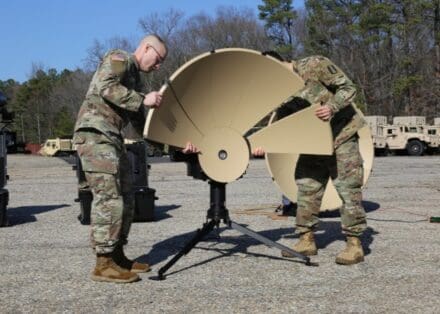
Alongside the pilot, the Army is accelerating the potential use of an “as a service” business model by concurrently leveraging lessons learned from other DOD efforts in the managed services realm, including those conducted by the U.S. Navy and Marine Corps.
Similarly, the Army is looking into the potential of leveraging a commercial “as a service” model for tactical radios as well, releasing a request for information to industry last month to gain further insight into such an effort. To further examine the pros and cons of the SaaMS model, the Army also leveraged John Hopkins University to conduct a SaaMS business case and cost analysis to aide in future lease-vs-buy decisions.
“[With SaaMS,] we can adjust the scope of technology adoption based on needs and budget, allowing us to test and evaluate new solutions before full-scale deployment,” Sullivan said. “[Additionally,] we only pay for what we use, eliminating costly unused capacity during low-intensity periods…and we eliminate the need to maintain and manage diverse communication equipment. This frees up resources for other mission-critical needs.”
By Amy Walker, Project Manager Tactical Network, PEO C3T, Public Affairs
EWAAC will provide contract vehicle for Air Force commands seeking mobile ad hoc networking solutions.
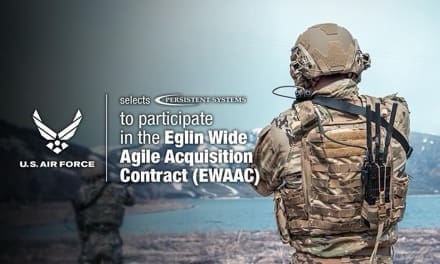
Persistent Systems (“Persistent”), a leader in mobile ad hoc networking (MANET), announced today that it has been selected by the U.S. Air Force to participate in the multi-vendor Eglin Wide Agile Acquisition Contract (EWAAC), a $46 billion Indefinite Delivery/Indefinite Quantity (IDIQ) rapid acquisition vehicle for the development of novel weapons capabilities.
Participating in EWAAC enables Persistent Systems to better support networked autonomy efforts with the Air Force Research Laboratory (AFRL) as well as provide other Air Force customers, such as Global Strike Command and Air Combat Command, with a ready-to-use contract vehicle.
“We are very excited to be selected by the Air Force Life Cycle Management Center to participate in the Armament Directorate’s EWAAC,” said Cody Larson, director of Business Development at Persistent Systems. “EWAAC will help us with our networked weapons development efforts, the goal of which is to develop air-launched, swarming weapons that share information for increased survivability and lethality.”
EWAAC places an emphasis on digital engineering, agile software, and open systems architecture. Meeting those goals, Persistent’s Wave Relay® MANET is data-agnostic and capable of passing any digital data, allowing it to adapt to ever-changing, open-architecture weapons systems.
“This further deepens the relationship between Persistent and the U.S. Air Force to support emerging concepts like JADC2 and other programs,” said Adrien Robenhymer, VP of Business Development for the Air Force and Intelligence Community, at Persistent Systems.
JACKSONVILLE, Florida – Safariland®, a brand of The Safariland Group®, a leading global provider of safety products designed for the public safety, military, professional and outdoor markets and one of Cadre Holdings, Inc.’s (NYSE: CDRE) (“Cadre”) key brands, announces an exclusive collaboration with Noveske Rifleworks. Launching the Liberator® HP headset in Noveske’s signature N81 camo brings together two industry-leading brands, offering customers a limited-edition product that combines cutting-edge technology with a unique design.

Known for its exceptional quality and innovation, Noveske Rifleworks brings expertise and style to the table, elevating the Liberator HP look and feel. The N81 camo print, designed and cerakoted in-house by Noveske, is meticulously applied to the Liberator HP earcups, striking a perfect balance between visual appeal and high-performance functionality.

The Liberator HP headset represents the next generation in electronic hearing protection. Designed to withstand the rigors of any environment, this cutting-edge headset offers enhanced hearing protection, particularly in situations involving impulse gunfire noise and high-decibel, constant background audio. Wearers can rest assured knowing they are fully protected, while advanced sound localization technology allows for maximum situational awareness and sound detection.
“This Liberator HP exclusive marks the beginning of our collaboration with Noveske,” said Timothy Drnec, VP of Marketing for Safariland. “By combining our expertise in protective equipment with Noveske’s renowned craftsmanship, we are able to offer our customers a modern take on range gear.”
“Noveske is about building a community founded on the mutual respect of creating high quality product. We’re thrilled to work alongside Safariland in producing a limited run of Liberator HPs as the start of a fun and collaborative partnership and we’re excited to see what comes next,” said Jeff Pool, President of Novekse Rifleworks.
With limited sets available, the Safariland Liberator HP exclusive edition with Noveske cerakote is one of this year’s hot ticket items for the range and shooting enthusiasts.
To learn more about this exciting new release and to explore Safariland’s extensive range of holsters and tactical accessories, visit Safariland.com.